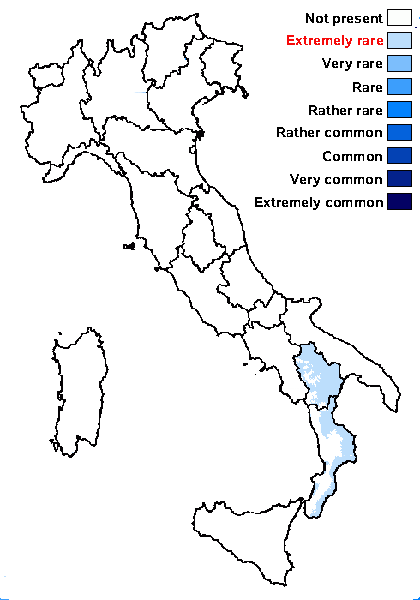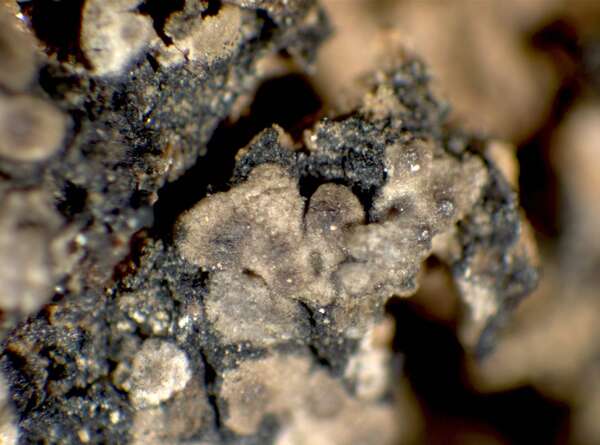Placidiopsis tenella (Nyl.) Zahlbr.
Cat. Lich. Univ., 1: 204, 1922. Basionym: Endocarpon tenellum Nyl. - Ann. Sci. Nat., Bot., sér. 3, 20: 316, 1853
Synonyms: Bohleria tenella (Nyl.) Trevis.
Distribution: S - Bas (Potenza & al. 2010), Cal.
Description: Thallus squamulose, whitish to greenish grey, sometimes pale brown, epruinose, the squamules 1-2 mm broad, irregularly rounded to crenate-lobulate, flattened to convex, smooth, contiguous, not imbricate. Lower surface pale, attached by 2.5-4 μm thick, colourless rhizohyphae. Upper cortex pseudoparenchymatous, 10-25 μm thick, covered by a 10-15 μm thick epinecral layer; lower cortex absent. Perithecia frequent, laminal, immersed in the squamules, globose, with a colourless wall and a dark apical involucrellum, 0.2-0.3 mm across, the involucrellum small, flat, appearing as a blackish rim around the ostiole. Exciple colourless to pale brown, of tangentially arranged, elongate cells; paraphyses absent, substituted by periphyses measuring 20-30 x 2.5-3 μm; hymenium I+ reddish. Asci 8-spored, clavate, thin-walled, I-, apically slightly thickened, with a small ocular chamber. Ascospores 1-septate, hyaline, narrowly ellipsoid, thin-walled, 14-18 x 6-7 μm. Photobiont chlorococcoid. Spot tests: cortex and medulla K-, C-, KC-, P-, UV-. Chemistry: without lichen substances.Note: this is a critical taxon. According to Breuss (1996) the species was often confused with P. cinerascens, from which it mainly differs in the presence of a small involucrellum, being known with certainty only from Algeria and Calabria. Molecular data by Prieto & al. (2010) revealed the presence of 2 clades in samples of P. cinerascens and P. tenella, but did not find any correlation between those and the presence/absence of an involucrellum, so that they proposed to consider P. tenella as a synonym of P. cinerascens. Pending further study, I still maintain here the two species as separate.
Growth form: Squamulose
Substrata: soil, terricolous mosses, and plant debris
Photobiont: green algae other than Trentepohlia
Reproductive strategy: mainly sexual
Poorly known taxon in need of further study
Commonnes-rarity: (info)
Alpine belt: absent
Subalpine belt: absent
Oromediterranean belt: absent
Montane belt: absent
Submediterranean belt: extremely rare
Padanian area: absent
Humid submediterranean belt: absent
Humid mediterranean belt: extremely rare
Dry mediterranean belt: extremely rare

Predictive model
Growth form: Squamulose
Substrata: soil, terricolous mosses, and plant debris
Photobiont: green algae other than Trentepohlia
Reproductive strategy: mainly sexual
Poorly known taxon in need of further study
Commonnes-rarity: (info)
Alpine belt: absent
Subalpine belt: absent
Oromediterranean belt: absent
Montane belt: absent
Submediterranean belt: extremely rare
Padanian area: absent
Humid submediterranean belt: absent
Humid mediterranean belt: extremely rare
Dry mediterranean belt: extremely rare

Predictive model
 Index Fungorum
Index Fungorum
 GBIF
GBIF



